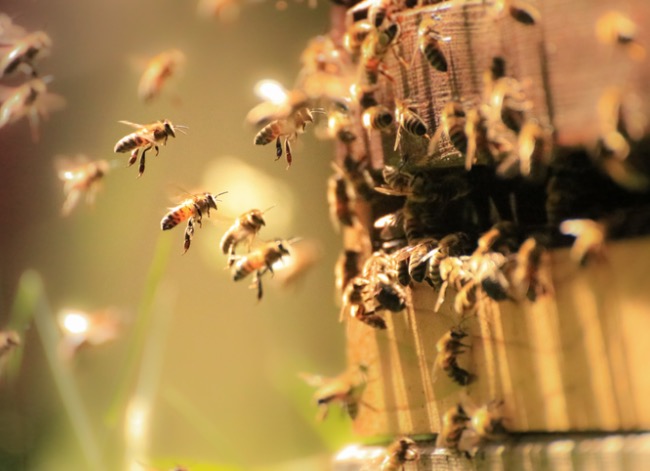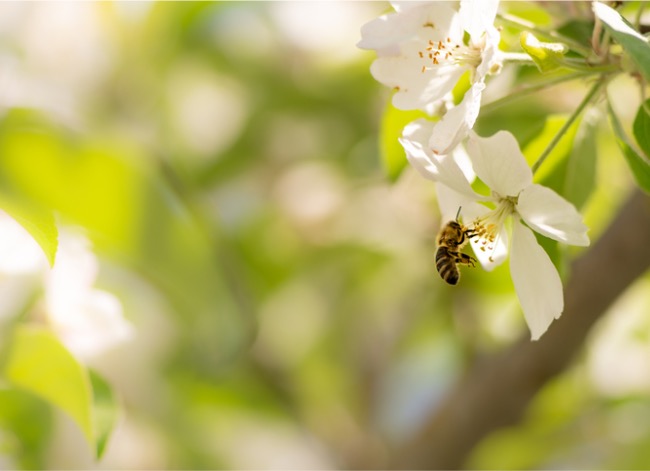

We may earn revenue from the products available on this page and participate in affiliate programs. Learn More ›
They’re both somewhat fuzzy, they are both very buzzy, and they are both members of the Apidae family, which includes more than 5,700 species of bees found on every continent other than Antarctica. While carpenter bees and bumblebees share many similarities, they are distinct insects with a different appearance, habits, and life cycle.
Although you’re unlikely to ever witness a true battle between a carpenter bee and bumblebee, it’s helpful to know the differences between the two. While both are beneficial pollinators, one potentially is a destructive pest.
Read on for a head-to-head comparison of the carpenter bee versus the bumblebee.
Check out their fuzz.
Both bumblebees and carpenter bees are insects, and as such, have bodies divided into three parts (head, thorax, and abdomen), three sets of jointed legs, and a pair of antennae. Like many other insects, they have two sets of small wings. Both are roughly one inch in length, and are typically black and yellow.
Bumblebees belong to the genus Bombus, which contains around 250 species. Carpenter bees are members of the genus Xylocopa; there are around 500 species in this group. Despite their taxonomic differences, the common species of bumblebees and carpenter bees found in North America are quite similar in appearance, leading to confusion as to which is which.
Where the easiest-to-spot difference appears is in the abdomen. If you look closely, you’ll see that while bumblebees have fuzzy abdomens, usually with black and yellow stripes, carpenter bees have bare, shiny black abdomens. Both insects have plenty of yellow fuzz on their thoraxes and fuzz on their heads as well, although bumblebees have fuzzier heads than carpenter bees.
RELATED: 12 Ways to Be a Good Neighbor—to Your Backyard Wildlife
They choose different nesting sites.
Like other species of bees, bumblebees and carpenter bees build nests. Unlike honeybees, however, you won’t find them hanging out in a hive, nor does either type create honeycombs or produce honey. Instead, bumblebees prefer to nest underground, while carpenter bees, as the name suggests, make their nests in wood.
Bumblebees create a new nest each year. Most often, they choose a dry, somewhat shady spot that isn’t heavily trafficked. Direct sun locations are avoided, as too much sun can overheat the nest. Prime locations include underneath woodpiles, compost heaps, heavy brush, thick grass, or inside abandoned rodent holes and tunnels. Occasionally, the bumblebee queen will choose a spot underneath a shed, in a decaying log or tree stump, or even inside a bird nest or birdhouse for her colony’s home.
Carpenter bees, by contrast, make their nests in wood. While they have a very strong preference for unpainted, weathered, soft wood, they sometimes do make their nests in painted or new wood if there aren’t better options nearby. With their powerful mandibles, female carpenter bees drill a perfectly round, ½-inch diameter hole into the wood, creating a tell-tale small pile of sawdust beneath the hole. The bee burrows straight ahead for an inch or two before taking a sharp turn and then continuing onwards in a straight line, with small chambers branching off the main tunnel. Over time, these tunnels can reach several feet in length, as carpenter bees reuse the tunnels each year. Unlike termites, carpenter bees do not actually eat wood. They just tunnel into it.

Both are pollinators, but one can be a pest.
Like other types of bees, bumblebees and carpenter bees are important pollinators, helping plants reproduce by spreading pollen from flower to flower. Both feed on nectar within flowers, but also gather up pollen to bring back to their nests. Because both are fairly large insects, they tend to prefer shallow, open-faced flowers, but also crawl into tubular flowers that offer abundant supplies of nectar.
Both bumblebees and carpenter bees perform “buzz pollination,” meaning that they will grab onto the pollen-producing parts of the flower with their jaws, and then vibrate their wings very rapidly. The vibrations loosen the pollen grains, which are then gathered up by the bees and taken back to the nest, where the protein-rich pollen nourishes the bee larvae. Buzz pollination is especially important for many vegetable and fruit crops, including eggplants, tomatoes, all types of peppers, and many types of berries.
Despite their beneficial activities in the garden, many people harbor a grudge against carpenter bees. Although the bees usually stick to old trees for their nests, they can and do drill into wooden fences, outdoor furniture, and exterior house trim. And along with the damage to the wood, carpenter bee droppings tend to create unsightly yellowish stains around the entrance to their nests.
RELATED: 3 Container Garden Combos for Attracting Pollinators

One is social, the other not so much.
Like honeybees, bumblebees are social creatures that live in colonies with strict hierarchies. The queen bee is the most important member of the colony, followed by the sterile female worker bees, and then the males, who mate with the queen but do not work to bring food back to the nest. As a general rule, bumblebee colonies are much smaller than honeybee colonies. A typical bumblebee colony has only 50 to 500 members, whereas a large honeybee colony might contain tens of thousands of bees. And unlike honeybee colonies, which typically live through the winter, most species of bumblebees die off as cold weather sets in, with only the mated queen hibernating over the winter. She will emerge in the spring to lay her eggs and start the cycle over again.
Carpenter bees are solitary insects for the most part, other than when breeding. They do not live in large colonies or have a social hierarchy. One male and one female carpenter bee will establish a nest, which the female builds and maintains while the male remains nearby to offer protection from potential threats, including other insects, birds, and animals. Unlike honeybees and bumblebees, the female carpenter bee does not care for her young; instead, she leaves a packet of pollen with each egg to serve as a food source until the young bees are old enough to leave the nest and forage on their own. Carpenter bees can live for up to 3 years, hibernating over the winter months before venturing out in the spring to reproduce.
One is more likely to sting than the other.
As with other types of bees, only female bumblebees and carpenter bees have stingers. But unlike honeybees, which have barbed stingers that tear off after delivering a sting, both bumblebees and carpenter bees have smooth stingers that remain attached to their owner, allowing an individual bee the chance to sting multiple times.
Still, both types of bees are fairly docile, and tend to maintain a “Don’t bother me and I won’t bother you” attitude. As long as you don’t swat at them, touch them, threaten their nests, or otherwise interfere with their comings and goings, you are very unlikely to be stung by either a carpenter bee or a bumblebee. If one or the other ever stings you, chances are it will be a bumblebee, as they are more invested in protecting their queen and their colony than solitary carpenter bees.
Male carpenter bees, however, are known for their show of aggression when protecting their nest. While they cannot sting you, they definitely will threaten you by swooping towards your head and swirling around you while buzzing loudly. Just remember it’s all for show: the male bee lacks a stinger, so his bravado is his only real defense.

